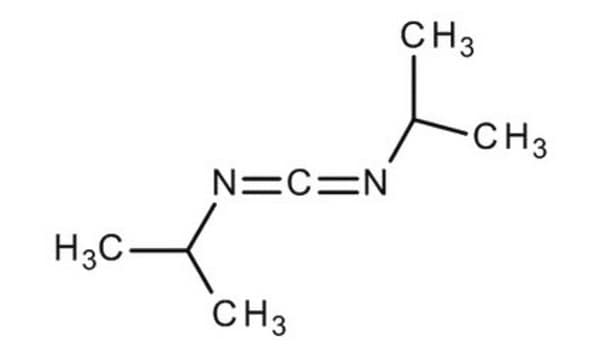901609
Diisopropylcarbodiimide solution
1 M in dichloromethane
Sinonimo/i:
Diisopropylmethanediimine
About This Item
Prodotti consigliati
Forma fisica
liquid
Impiego in reazioni chimiche
reaction type: Coupling Reactions
Concentrazione
1 M in dichloromethane
Indice di rifrazione
n/D 1.4251
Densità
1.2231
applicazioni
peptide synthesis
InChI
1S/C7H14N2/c1-6(2)8-5-9-7(3)4/h6-7H,1-4H3
BDNKZNFMNDZQMI-UHFFFAOYSA-N
Cerchi prodotti simili? Visita Guida al confronto tra prodotti
Descrizione generale
Applicazioni
- Alternative to dicyclohexylcarbodiimide in peptide synthesis.
- Coupling reagent for peptide syntheses.
- DIC (N,N′-Diisopropylcarbodiimide) has been used in combination with 1-hydroxy-7-azabenzotriazole (HOAt) for the coupling of amino acid with N-allylglycine to form N-allylpeptide.
Prodotti correlati
Avvertenze
Danger
Indicazioni di pericolo
Classi di pericolo
Acute Tox. 2 Inhalation - Carc. 2 - Eye Dam. 1 - Flam. Liq. 3 - Resp. Sens. 1 - Skin Irrit. 2 - Skin Sens. 1 - STOT SE 3
Organi bersaglio
Central nervous system
Codice della classe di stoccaggio
3 - Flammable liquids
Classe di pericolosità dell'acqua (WGK)
WGK 3
Punto d’infiammabilità (°F)
91.4 °F
Punto d’infiammabilità (°C)
33 °C
Certificati d'analisi (COA)
Cerca il Certificati d'analisi (COA) digitando il numero di lotto/batch corrispondente. I numeri di lotto o di batch sono stampati sull'etichetta dei prodotti dopo la parola ‘Lotto’ o ‘Batch’.
Possiedi già questo prodotto?
I documenti relativi ai prodotti acquistati recentemente sono disponibili nell’Archivio dei documenti.
Il team dei nostri ricercatori vanta grande esperienza in tutte le aree della ricerca quali Life Science, scienza dei materiali, sintesi chimica, cromatografia, discipline analitiche, ecc..
Contatta l'Assistenza Tecnica.











